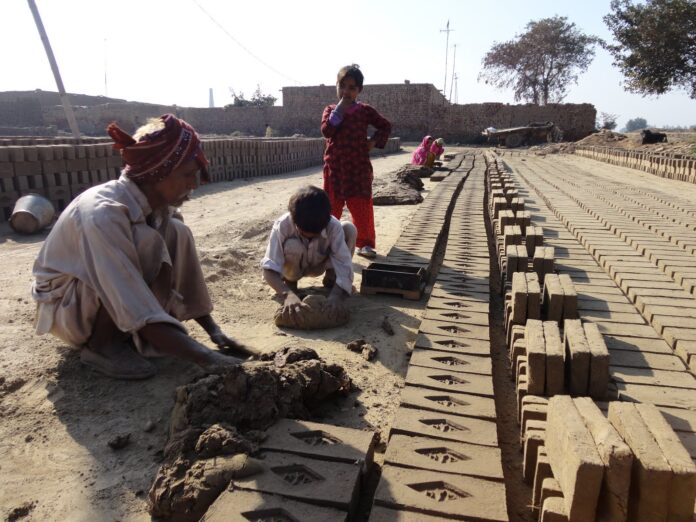Look around you, whether you are sitting in your homes, or offices, or out on the road. Every wall, and every towering structure from the houses of parliament to every roadside footpath, and every garden boundary are made of bricks. Hundreds of millions of these small red blocks of baked mud that have been around since 700BC make up the cities that we live in.
Not to far away from the comfort and security of the homes we build with these bricks, on the outskirts of major cities like Lahore, an insidious system of modern age slavery makes sure that a steady supply continues to stream into our cities. Bonded labour was outlawed in Pakistan years ago, despite which men, women, and children continue to be trapped in a vicious cycle that engulfs the lives of generations.
An Al Jazeera report from 2019 estimated that in the 20,000 brick kilns that exist in Pakistan, there are 4.5 million employees, most of whom are trapped in debt bondage. There are at least 3.1 million workers that are trapped in debt bondage for sure, and nearly a million of them are children under the age of 16. At the brick kilns, they are supposed to be paid Rs 960 a day for which they are supposed to produce 1000 bricks a day. If they produce fewer bricks, they get less money.
Conditions at these kilns are harrowing, with the mud mixture that is used to produce bricks giving workers skin diseases, and coal giving them pulmonary problems. Most of the workers are there because they have no other choice, with the owners of these kilns using techniques ranging from terror, law enforcement, and chains, to keeping the children of workers hostages to ensure the workers are unable to escape the debt trap. Their continued suffering should be a moral burden on the conscience of the entire nation.
And while the biggest example of bonded labour in Pakistan is in brick kilns, this system of slavery exists outside of the kilns as well. In agricultural fields as harvesters and in large houses in posh areas as domestic help – bonded labour has trapped millions of families whose plight continues to be ignored, and whose labour all of us continue to benefit from.
For years, the Bonded Labour Liberation Front has been doing fine work in helping workers get out of this illegal debt bondage, but in the past couple of years, the Punjab government through the Punjab Labour & Human Resource Department (PL&HRD) has undertaken projects to remove this scourge from the province. How successful have they been, and how long will it be until we can rid ourselves of this evil?
How it happens
How bonded labourers become bonded labourers is always a story of desperation. On the outskirts of cities and in rural areas, it is not a profession that one aspires to. It is a dreaded field of work, and one that snaffles you not just for your own life but for the entire lives of your children and their children.

It begins with a moment of desperation. A woman has been widowed and there is no one to work and bring home the money for the children. A man has nothing saved up for the marriage of his daughter. A brother has no money to arrange medicine for his siblings. So they go to the brick kiln and they ask for a loan. The amount is usually paltry, but it is enough for them to be trapped.
In exchange for the loan, you begin working at the kiln, and this is where the exploitative practices begin. “Bonded labor means depriving a person of all basic rights, including freedom of movement and association, personal freedom, liberty or freedom of business / profession, freedom of expression and the right to equality among citizens,” explains Ansar Majeed Khan Niazi, the labour minister of Punjab.
“People under hard circumstances agreed to bonded labour and sometimes it is passed on from one generation to the other, depending upon what terms the forefathers agreed upon with the employer. The educated and elite social circle is also found involved in this practice where they have servants and labour working for them on lesser wages or as bonded labour.”
“To pay back this debt, the labor has to offer their basic freedom and services to the employers. According to Article 3 of the Constitution of Pakistan, it is the responsibility of the state to ensure the eradication of all forms of mistreatment and the plodding fulfillment of the basic principle that everyone will be rewarded according to his ability and according to his work.”
One labour director of Punjab Labour & Human Resource Department (PL&HRD), speaking on the condition of anonymity, believed that forced labour, primarily in the form of debt bondage, is commonly seen amongst low castes and social classes, minorities and migrants who suffer from additional discrimination and social segregation and they are the ones who are victimized.
“In the case of brick-kiln, usually an adult man, takes a loan or salary in advance from the employer. This loan is sometimes for the marriage of a daughter, meeting the needs of the house and family or some other crisis the person faces,” explains minister Niazi. “As a result the debtor, and in many cases their family members as well, are obligated to work for the employer for no wages at all or reduced wages until the debt is repaid.” This exploitative system does not even end with death, and at times a loan taken by a father is inherited by his children.
“The terms of the oral, interlinked labour credit contract are heavily biased in favour of the lender and this is being done since ages to exploit the poor. To meet the daily needs and family demands, the worker is forced to borrow additional cash and the amount is amplified and doubled,” he explains. “When there are larger debts, these strengthen the employer’s control to such an extent that the basic freedom including the freedom of expression, association, movement, and to undertake alternative employment is denied by the employer and there is no way of escape for the labour.”
In some of the worst cases. the workers are imprisoned and dealt with violence or threats of vehemence. They are often chained and beaten and left without food or drink. Further, it is a routine that females in lower income groups and classes are kept away from decision making and neither are they made a part of the discussion, so finally they have to agree to all the terms and conditions which their men agreed to with the employers. This makes them bonded labour and their children too,” Niazi further added.
Here comes a project
With all this going on, a director of the PL&HRD told Profit that the Government of Punjab is on a mission of eradicating bonded labour and in order to exterminate the bonded labour from the society, the PL&HRD undertook a six years project (2012-18). Now, the PL&HRD through its Annual Development Programme has launched a project called the ‘Elimination of Bonded Labour in 4 Districts of Punjab (EBLIK-4D)’ in 2012-2020 at the cost of Rs 196.836 million in four districts of Punjab, namely, Faisalabad, Gujarat, Sargodha & Bahawalpur.
“The project was proposed to be extended till June 2020 for Elimination of Bonded Labour in the Brick-Kilns of four districts of Punjab, namely, Sargodha, Faisalabad, Gujrat, Bahawalpur, Districts in order to duplicate the interventions of similar project being implemented in Lahore and Kasur districts.”
He further explained to Profit that in the past development funds had been allocated to address the vital issue of bonded labour and to cater the social and economic needs of vulnerable groups of population. “Based on the impact assessment of the EBLIK project being implemented in Lahore and Kasur districts, stakeholders consultation and a wide-ranging review of the existing literature on bonded labour in the brick-kiln sector in Pakistan, the project proposed a set of activities that were necessary to eliminate debt-bondage in the brick kiln of the four selected districts of Pakistan.”
The project was started by the PL&HR Department during the period 2012-20 but was delayed recently due to the Covid-19 pandemic. The project included ways and means to improve brick-kiln workers’ access to social services, legal recourse and to improve the health and hygiene of brick kiln workers. Although the scope of the Elimination of Bonded Labour in Brick-Kilns (EBLIK-4D) Project was limited to brick kilns in the selected districts, the interventions were possibly replicable to other districts and sectors as well.
Speaking about the project components, the director mentioned that there were a set of thirteen interventions which included, provision of non-formal education to children of families at brick kilns and adult literacy for other family members, promotion of health and hygiene services among the brick kiln workers (women/men), and health Screening Camps for brick workers and their family members. Veterinary services, facilitation in acquiring CNICs for adults, and birth registration of children, as well as the provision of legal services to the brick kiln workers are also included in all these services.
“Political will to block and ban the concept of bonded labour has been growing over past and recent years whereas the successive governments have also legislated against various types of bonded labourers,” director said. For years, one of the major problems has been that politicians have either owned or had stakes in many of these brick kilns practicing bonded labour. Now, however, there seems to be more willingness to take the issue on despite political pressure not to bring it up.
The implementation of these laws posed a serious challenge to the state’s institutions. On the other hand, many civil society organizations have also worked and generated awareness in this regard and made it public that bonded labour should be stopped. “The capacity and scale of activities of the nonprofit and civil society organizations is limited as they have their own resources and sometimes agendas, therefore they can also not play a pivotal role in the awareness. Many civil societies in the past and till today are trying to fight against this dilemma but their scale and scope is limited,” says the director.
“All they do is create awareness among the elites and the locals of the area but have no solid outcomes. It has to be done at the government level and media. The International Labour Organization (ILO) has been an important partner in public sector and non-profit initiatives. In addition to the localized and small-scale public/private/international initiatives, it is essential that the government, NGOs and ILO work in partnership for a concerted effort for the prevention and elimination of bonded labour in Pakistan,” he commented on the role of civil society organizations.”
The scale of the project
The labour minister says that according to registration data of the PL&HRD, the number of registered brick kilns in the target districts is 479 in Gujrat, 319 in Sargodha, Faisalabad 485, Bahawalpur 400, with the total number adding up to 1683. However, the director PL&HRD believed that the kilns varied in sizes according to their production capacity and working while depending upon that the number of labour is decided.
“On an average it can be estimated that a kiln in the mentioned districts employs 10 families on an average at one kiln,” he added. He further explained that the average work force of five persons, which includes two adults and three children per family, the average work force on one kiln is about 100 persons. “If you visit a kiln, you will see families working there and all age groups are seen. There are cases where there are more children than adults in a family. This is balanced by those workers who do not have any families. There are approximately 16830 families at the kilns and the total number of workers comes out to be around 84150 persons. This number also includes the females and children of the families,” he said.
There are different categories of work that are done in the kilns. Most of the men are responsible for the dangerous work of putting and removing the bricks from the oven in which they are baked. The women and the children are usually given the work of packing the mud into the brick moulds. However, most of the families work in units, and their wages are clubbed together in the name of the head of the family. This clubbing of wages is actually the root cause of extreme forms of exploitation practiced in the kilns. The wages are clearly less than the rate notified by the Government of Punjab as well as the market rate for semi-skilled labour.
“Calculations of market rate reveal a higher degree of exploitation in these kilns and that is unfair with the people working there. This is the height of exploitation by the employers and it should be curbed. Presently, the market rate for semi-skilled labour on daily wages is RS 400- 500 per person and that for unskilled labour is RS 300 per person. If we assume the rate for a female worker to be 2/3rd of the market rate, and that for children to be 1⁄2, the wages per day for a family of 5 having one adult male, one adult female and three 3 children of various ages, would be RS 1050 per day. We are assuming here that the adult male is a semi-skilled worker and the adult female and the minor children are unskilled workers. The above calculations show the scale of exploitation which debt bondage at brick kilns leads to. That a family accepts the lower rate of RS 300-350 per family per day whereas each family would make around 1000 – 1200 bricks on a good day on average, this speaks volumes of the exploitation,” said the department director.
The official also added that a research study on the ‘Nature and dimensions of bonded labour in brick was also conducted with the support of the Social Work Department, University of Punjab Lahore. Research reports could not be published due to the closure of the universities on account of COVID-19 and lock down in the country. External verification of brick kilns for elimination of bonded labour was also to be done but had to be postponed due to COVID-19 and lock down in the country all the activities of the project were stopped.
The official, while talking about the objectives of the project and commenting on the development of online database (MIS) and Geo tagging of the brick kilns, said, that the development of MIS database is under process but could not be completed due to lockdown in the country on account of COVID-19. “Till the submission of PC-IV and for completion of the activity project management had requested the administrative Department for extension in gestation period but extension was not permitted.”
The project is also playing an essential role in informing the brick kilns community to eradicate the bonded labour from four target districts of Punjab. “The Labour & HR Department is providing the information to various national & international agencies on addressing the bonded labour subject in the province,” he said. “The brick kilns community would be sensitized through conducting awareness sessions, multi stakeholders dialogues and linkages with social safety networks. The role District Vigilance Committees will be further strengthening to address the bonded labour matter at district level in Punjab. It is also recommended that indicators should be verifiable for provision of health and hygiene services, veterinary services for smooth implementation, monitoring and evaluation of such interventions otherwise the labour would keep on suffering.”
“It is further recommended that PL&HRD may strengthen liaison and improve its harmonization with other government departments to establish connection between brick kiln workers & families with the nearby accessible social services and facilities of the Livestock & Dairy Development Department. An effective, efficient and gender sensitive social mobilization strategy for mobilizing communities at brick kilns was also needed to help monitor the project interventions and issues related to bonded labour.
Up until now, however, the project has not achieved its goals. According to Niazi, the main reason for this has been Covid-19. This is an unsatisfactory explanation, especially since the construction industry has been active this entire pandemic and brick kilns have continued to operate. It should also be a better time to get these workers out of bondage. “Our government’s priority is to eliminate bonded labor and introduce labor-friendly policies. In this regard, we have increased the monthly wages of workers from 17,500 to 19,500 with effect from July 1 this year. The wage has been fixed at Rs750,” he concluded.

























